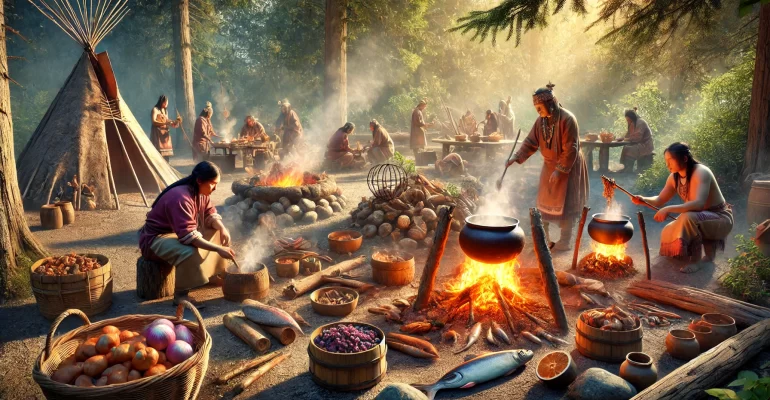Traditional Cooking Techniques: Amazing Indigenous Food Preparation Techniques in Canada
Traditional Cooking Techniques: Amazing Indigenous Food Preparation Techniques in Canada
Hello, food lovers and cooking enthusiasts! Are you ready to step into the fascinating world of traditional Indigenous cooking techniques? Here at WOCA Group, we’re always excited to explore and share the rich cultural practices of Indigenous peoples in Canada. Today, we’re going to discover some incredible ways that Indigenous communities have been preparing delicious and nutritious foods for thousands of years. So, put on your chef’s hat, and let’s get cooking!
Why Are Traditional Cooking Techniques Important?
Before we dive into the specific cooking methods, let’s talk about why these traditional techniques are so special:
- They’re time-tested: These methods have been perfected over thousands of years.
- They’re connected to the land: Many techniques make use of natural materials and local resources.
- They preserve food: Many traditional methods were developed to keep food fresh without refrigeration.
- They’re often healthier: These techniques often retain more nutrients than modern cooking methods.
- They carry cultural significance: Cooking techniques are often tied to stories, ceremonies, and traditions.
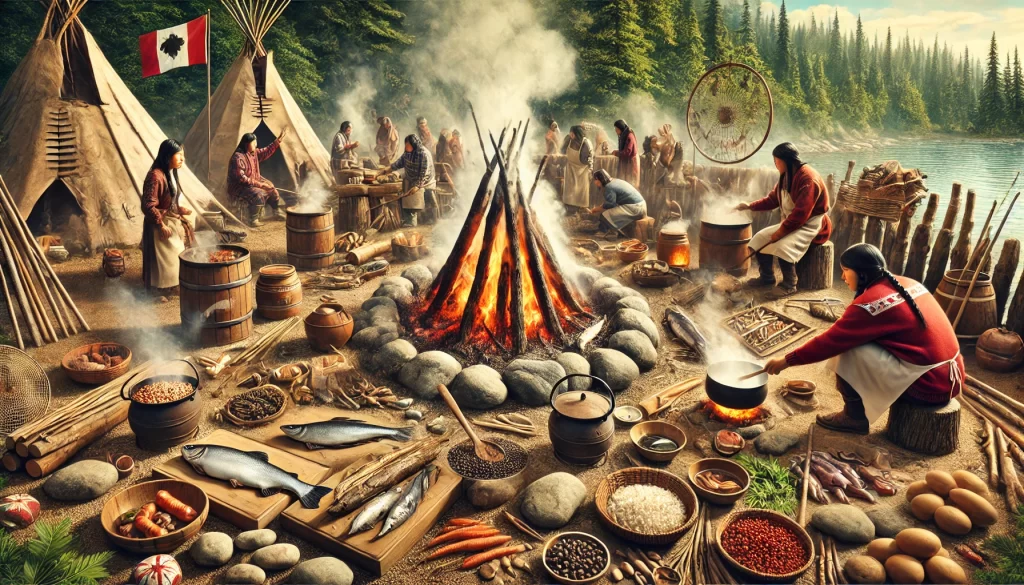
“Our cooking methods are like a bridge to our ancestors,” explains Elder Mary Firekeep. “When we use these techniques, we’re not just making a meal – we’re continuing a tradition that’s been passed down for generations.” Now, let’s explore some amazing traditional cooking techniques!
1. Earth Oven Cooking: Nature’s Slow Cooker
Earth oven cooking, also known as pit cooking, is like using the earth as a giant slow cooker. It’s a method used by many Indigenous groups across Canada.
How it works:
- Dig a pit in the ground.
- Heat rocks in a fire until they’re super hot.
- Place the hot rocks in the bottom of the pit.
- Add layers of plant materials like seaweed or leaves.
- Place the food (often wrapped in more leaves) on top.
- Cover everything with more plant materials, then soil.
- Let it cook for several hours or even overnight.
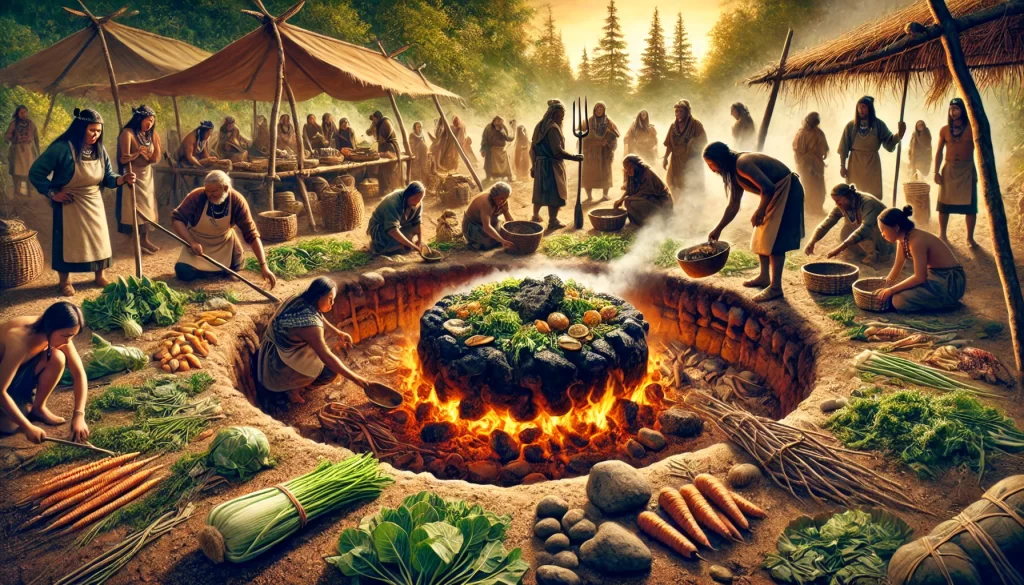
Foods often cooked this way include:
– Root vegetables like camas bulbs
– Whole animals like salmon or deer
– Shellfish like clams
“Earth oven cooking isn’t just about the food,” says Tom Earthchef, an Indigenous culinary expert. “It’s a community event. Everyone has a role, from digging the pit to gathering the right plants. And when the food comes out, it’s like unwrapping a delicious present from the earth!”
2. Smoking: Flavor and Preservation in One
Smoking is a super important technique used by many Indigenous groups, especially for preserving fish and meat.
How it works:
- Build a fire with hardwood (different woods give different flavors).
- Hang the food above the fire or place it on racks.
- Let the smoke surround the food for hours or even days.
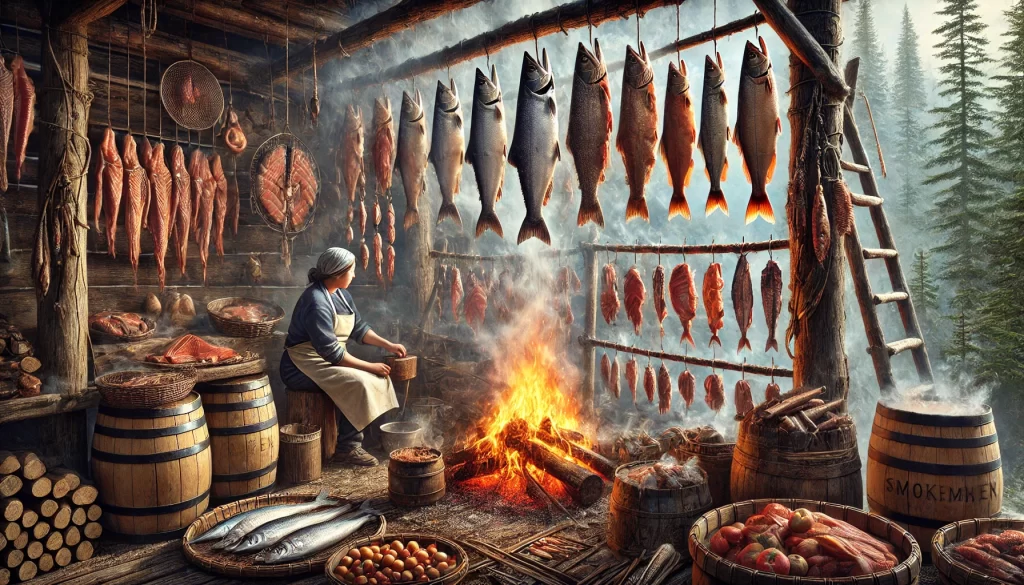
There are two main types of smoking:
– Hot smoking: Cooks and flavors the food
– Cold smoking: Just for flavor and preservation (the food is kept cool)
Foods often smoked include:
– Salmon and other fish
– Meat like deer or moose
– Some fruits and vegetables
“Smoking food is like an art,” explains Lisa Smokemaster. “You need to know which wood to use, how to control the temperature, and how long to smoke different foods. But when you get it right, the flavor is amazing, and the food can last for months!”
3. Pemmican Making: The Original Energy Bar
Pemmican is like a super-nutritious energy bar invented by Indigenous peoples. It was a crucial food for long journeys and harsh winters.
How it’s made:
- Dry thin strips of lean meat (usually bison, deer, or moose) in the sun or over a fire.
- Pound the dried meat into a fine powder.
- Mix in rendered animal fat.
- Add dried berries for flavor and extra nutrition.
- Pack the mixture tightly into animal skin bags or birchbark containers.
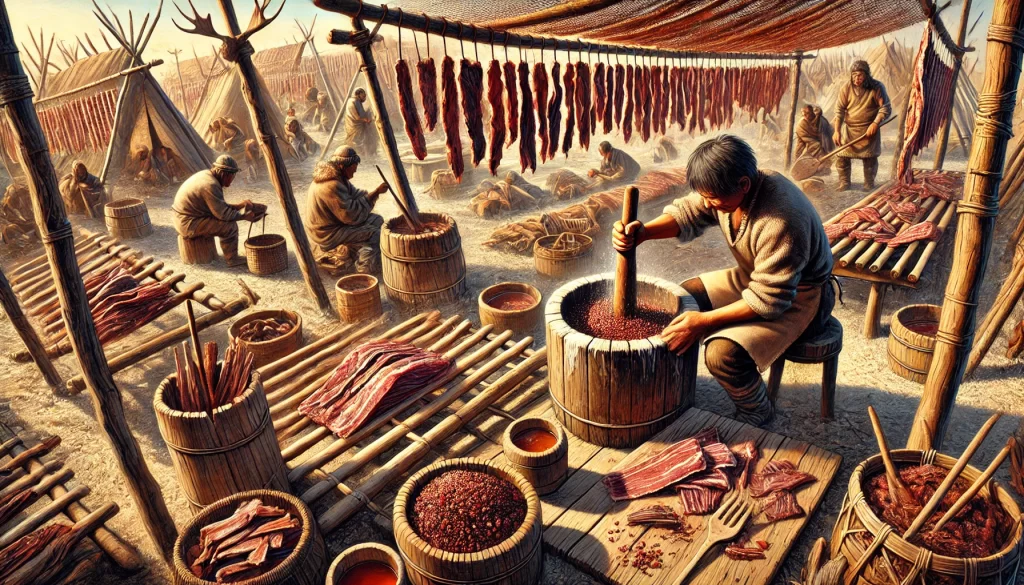
“Pemmican is incredible,” says nutritionist Dr. Sarah Healthwise. “It’s high in protein and healthy fats, and it can last for years without spoiling. It’s like the original superfood!”
4. Stone Boiling: Cooking Without a Pot
Stone boiling is a clever way of cooking liquid foods without using a metal pot (which many Indigenous groups didn’t have before European contact).
How it works:
- Heat rocks in a fire until they’re extremely hot.
- Carefully place the hot rocks into a container of liquid food (like stew or soup).
- The heat from the rocks cooks the food.
- Replace the cooling rocks with hot ones to keep the cooking process going.
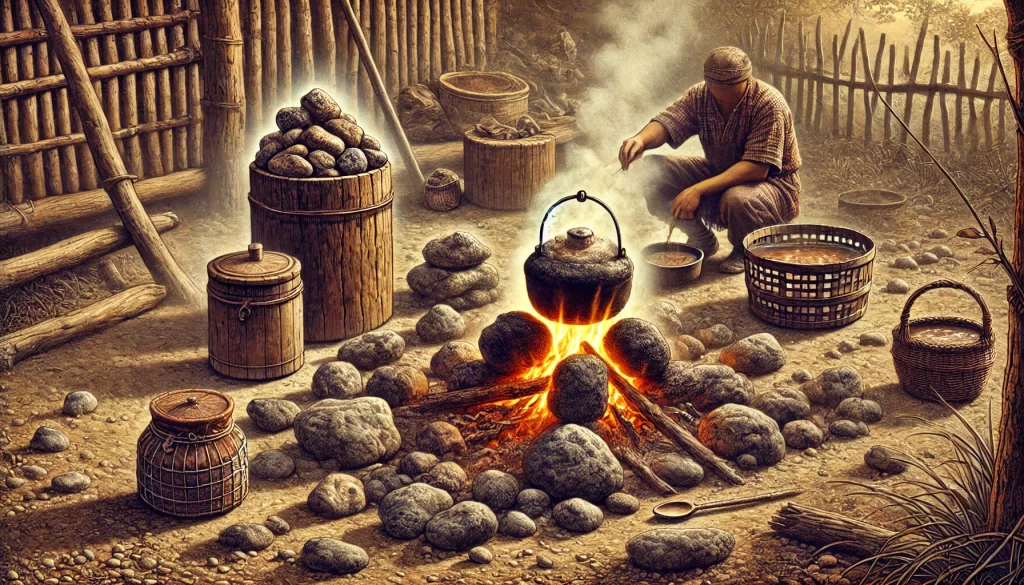
Containers used for stone boiling include:
– Watertight baskets
– Wooden boxes
– Animal stomachs or bladders
“Stone boiling is all about working with what nature provides,” explains Robert Stonecook. “It shows how innovative our ancestors were in using the resources around them.”
5. Drying and Dehydrating: Nature’s Preservation Technique
Drying food is one of the oldest and most effective ways of preserving it for long periods. Many Indigenous groups use this method for fruits, vegetables, and meats.
How it works:
- Slice the food into thin pieces.
- Lay the pieces out in the sun on racks or hang them on lines.
- For faster drying, use smoke or wind.
- Once completely dry, store in airtight containers.
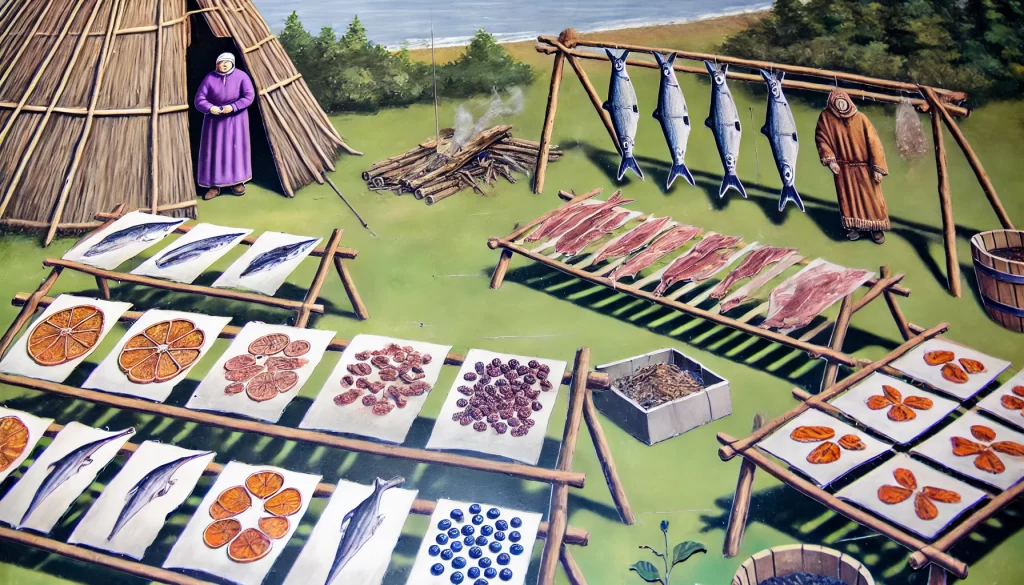
Foods often dried include:
– Berries (like saskatoon berries or blueberries)
– Meat (to make jerky)
– Fish
– Herbs and medicines
“Drying food is about more than just preservation,” says Elder John Berrykeeper. “It’s a way of concentrating flavors and nutrients. Dried foods were crucial for surviving long winters and are still an important part of many Indigenous diets today.”
6. Fermentation: The Power of Good Bacteria
While not as common as other methods, some Indigenous groups use fermentation to preserve foods and create unique flavors.
How it works:
- Place food in a container (often a pit in the ground).
- Add water and sometimes salt.
- Cover and let natural bacteria do their work.
- The fermentation process preserves the food and creates new flavors.
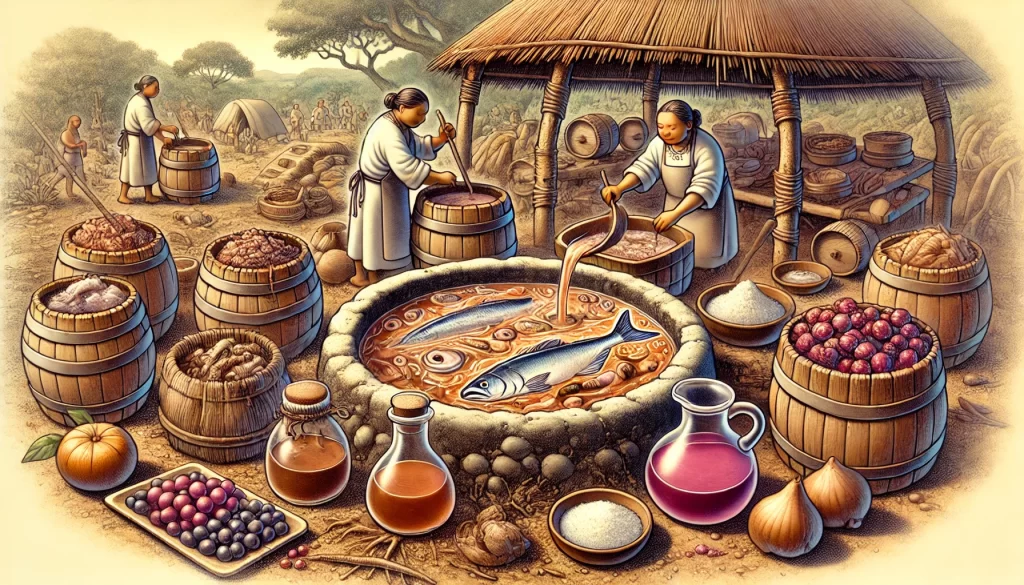
Foods sometimes fermented include:
– Fish (common in coastal communities)
– Berries
– Some plant roots
“Fermentation is like a kind of magic,” laughs Maria Fermentmaster. “You put food in the ground, and weeks later, you have something totally different and delicious!”
The Wisdom in Traditional Cooking Techniques
These traditional cooking methods aren’t just about making food taste good (although they definitely do that!). They’re packed with wisdom:
- Sustainability: Many of these methods use only renewable resources and produce no waste.
- Nutrition: Traditional techniques often preserve or even enhance the nutritional value of foods.
- Food Safety: Methods like smoking and drying help keep food safe to eat for long periods without modern refrigeration.
- Community Building: Many of these techniques involve the whole community working together.
- Connection to the Land: These methods rely on intimate knowledge of local plants, animals, and seasons.
“Our traditional cooking methods teach us to respect the food, the land it comes from, and each other,” says Elder Mary Wisdomkeeper. “They’re not just about feeding our bodies, but about nourishing our spirits and our communities.”
Keeping Traditions Alive: WOCA Group’s Cooking Workshops
Here at WOCA Group, we’re passionate about keeping these amazing cooking traditions alive. That’s why we offer hands-on workshops where you can learn some of these techniques:
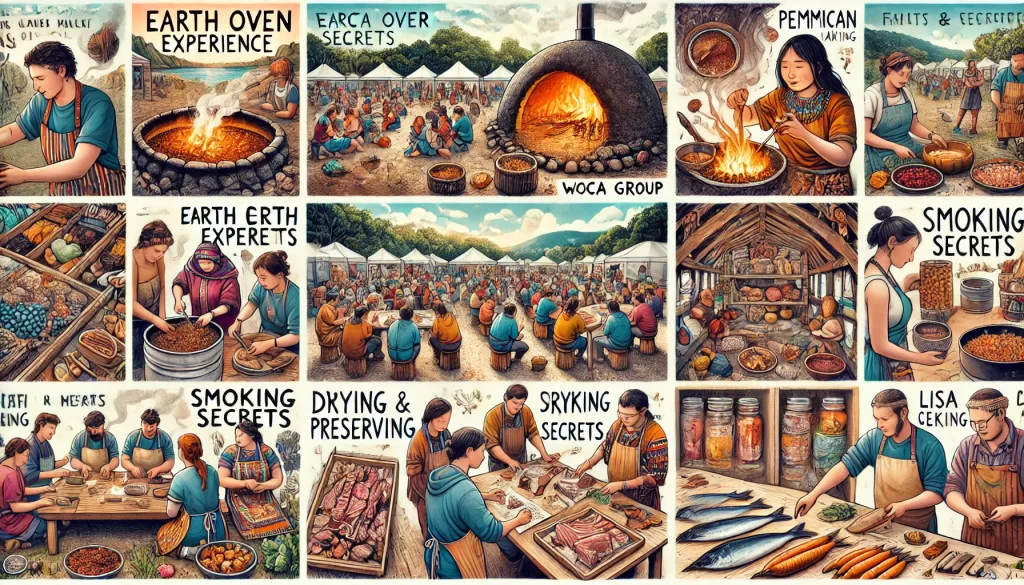
- Earth Oven Experience: Learn how to prepare, cook, and unearth a delicious meal from an earth oven.
- Smoking Secrets: Discover the art of smoking fish and meat.
- Pemmican Making: Try your hand at making this nutritious traditional food.
- Drying and Preserving: Learn how to dry fruits and make jerky the traditional way.
“Our cooking workshops are always a hit,” says Lisa Communitychef, WOCA Group’s event coordinator. “People love getting their hands dirty and experiencing these ancient techniques firsthand. It’s a delicious way to connect with Indigenous cultures!”
Try It Yourself: Bringing Tradition to Your Kitchen
While some traditional techniques (like earth oven cooking) might be tricky to do at home, there are ways you can incorporate Indigenous cooking wisdom into your own kitchen:
- Try smoking foods on your barbecue grill.
- Make a simple version of pemmican with dried meat, nuts, and dried fruits.
- Experiment with drying fruits and herbs.
- Use hot stones to keep soups warm at the table (be careful – they’re hot!).
- Learn about and cook with traditional Indigenous ingredients from your region.
Remember, when exploring these techniques and foods, it’s important to do so respectfully. Learn from Indigenous teachers when possible, and always give credit to the cultures these methods come from.
A Final Taste: The Ongoing Story of Indigenous Cooking
Traditional Indigenous cooking techniques are like a recipe that’s been perfected over thousands of years. They blend delicious flavors, smart food preservation, respect for the land, and community togetherness into one amazing meal. The next time you cook a meal, think about the wisdom behind these traditional techniques. Maybe you’ll be inspired to try smoking some fish, drying some berries, or joining us for a WOCA Group earth oven workshop!
Now it’s your turn! Have you ever tried any of these traditional cooking methods? Which one sounds the most interesting to you? Share your thoughts and culinary adventures in the comments below. Let’s keep the conversation going and celebrate the incredible world of Indigenous cooking techniques together! And don’t forget to check out WOCA Group’s upcoming cooking workshops. Together, we can keep these delicious traditions alive and cooking!

